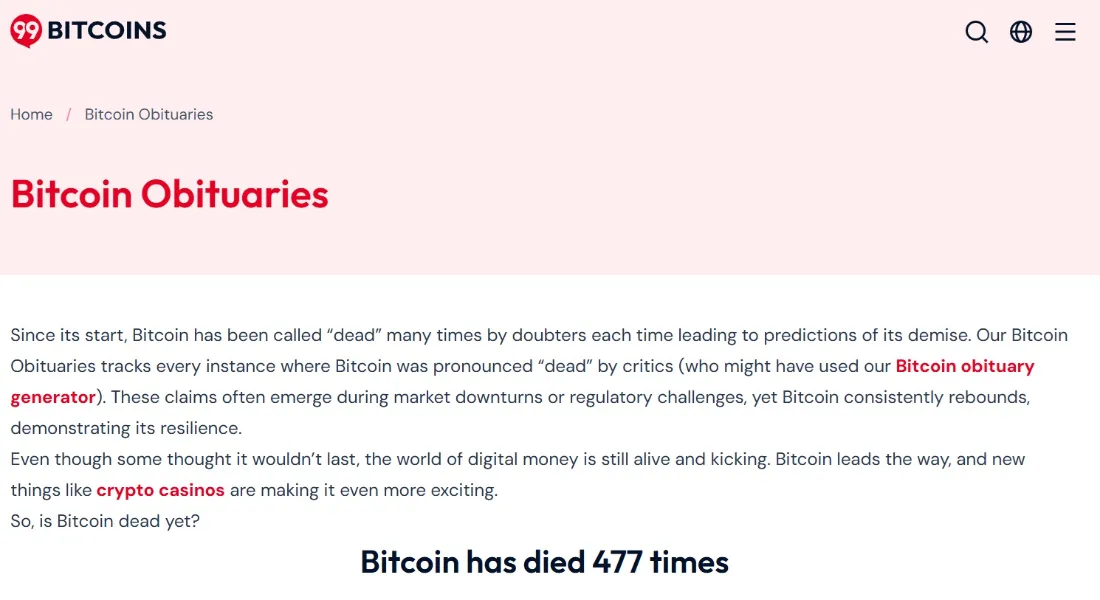BITCOIN OBITUARIES
December 7, 2018
1BTC:$3404.456700
- Artist
- Fact Date
- Fact #
- undefined
- Printing Specifications
- Paper / Stock
- Page Size
For almost as long as it has been alive, Bitcoin has been declared dead. Eventually, supporters grew tired of their cryptocurrency being declared deceased and decided to document the premature claims. Bitcoin Obituaries contains hundreds of incidents in which the currency’s demise was predicted by mainstream media.
Guest Written by Brian De Mint
If you judged Bitcoin’s longevity by headlines alone, you’d think it died somewhere between its pizza phase and its Silk Road scandal. Since 2010, the media has declared Bitcoin “dead” more than 470 times.
Each time, they say it with increasing hubris and certainty—like they are reporting on a collapsed building, or better yet, a martyred revolutionary whose movement was about to crumble in his absence, not an anti-fragile, decentralized worldwide protocol. Yet somehow, after every obituary, Bitcoin kept mining blocks every ten minutes like clockwork. Turns out, the death of Bitcoin has been one of the most exaggerated narratives in modern history. In fact, all who have made such public proclamations will be etched into the history books for their mid-wittery.
The site 99Bitcoins has been curating a list of these so-called “Bitcoin obituaries.” It's a digital graveyard of financial journalism’s premature eulogies.

“Bitcoin will never recover,” “The Altcoins will be like Facebook disrupting Bitcoin as Myspace”—headlines like these have spiked with every market downturn, and not surprisingly, many were published just before Bitcoin’s next bull run.
One can understand why these miscalculations were made in Bitcoin’s early days, but why have these death calls persisted in spite of such mainstream adoption? Part of it is psychological. Humans are wired to fear what they don’t understand. Bitcoin challenges fundamental assumptions about money, authority, and trust. That makes people uncomfortable—especially those who benefit from the status quo. And so, instead of learning about Bitcoin’s fundamentals—its capped supply, decentralized architecture, or self-healing open-source community—critics write it off as a fad, or worse, a fraud. But Bitcoin isn’t a meme. It’s mathematics. And the beauty of math is that it doesn’t care what CNBC says.
Let’s zoom out. Since its inception, Bitcoin has survived Mt. Gox, China bans, fork wars, media smear campaigns, and some of the most violent price crashes in financial history. Each time, the obituary writers sharpened their pens—and each time, Bitcoin rebounded, always stronger than before. It’s antifragile. It doesn’t just survive chaos—it adapts, evolves, and expands in response to it. In the early days, it was easy to mock. Bitcoin was the pet project of internet libertarians and cypherpunks.
But today, Bitcoin is being adopted by public companies, nations, pension funds, and payment processors. The “magic internet money” is now held in cold storage by sovereign wealth funds. What was once dismissed as a toy is now being treated as an economic firewall.
Every obituary is a timestamp of misunderstanding—a snapshot of a world that couldn’t yet see the paradigm shift unfolding before it. The truth is, Bitcoin doesn’t need everyone to believe in it right now. It just needs to keep doing what it’s always done: process blocks, protect users, and provide an incorruptible alternative to broken systems. Eventually, reality catches up. So when the next wave of articles declare Bitcoin dead, don’t panic. Smile. Because if history has taught us anything, it’s that Bitcoin doesn’t die—it just keeps proving people wrong. And the ledger remembers everything. Even the funerals that never were.
- Artist
- XXXXX
- BTC On this day
- December 7, 2018
- Market Cap
- $59,275,974,385
- Block Number
- 553,934
- Hash Rate
- 34,683,178.401 TH/s
- Price Change (1M)
47%
- Price Change (3M)
44%
- Price Change (1Y)
79%
